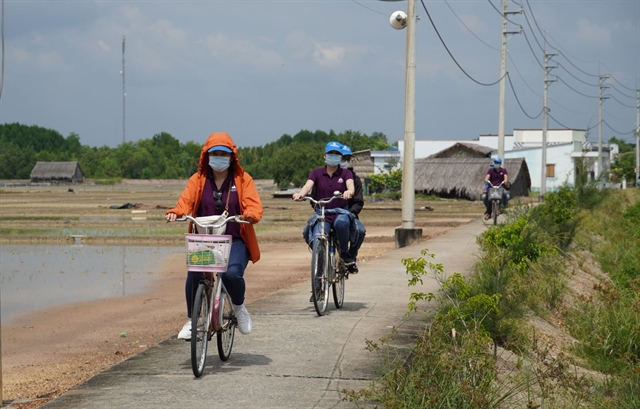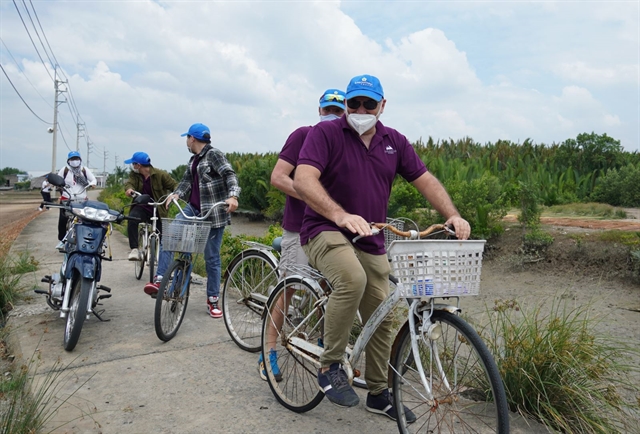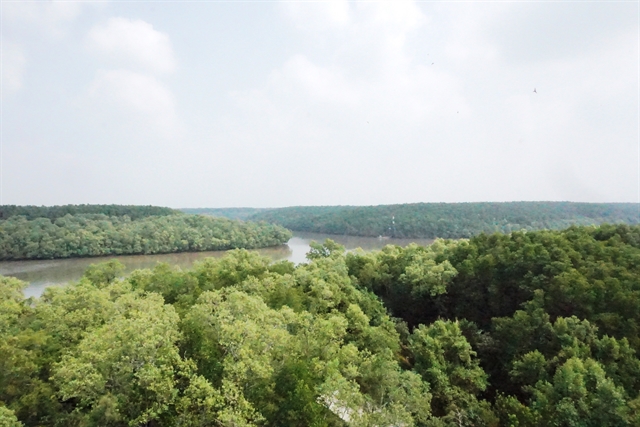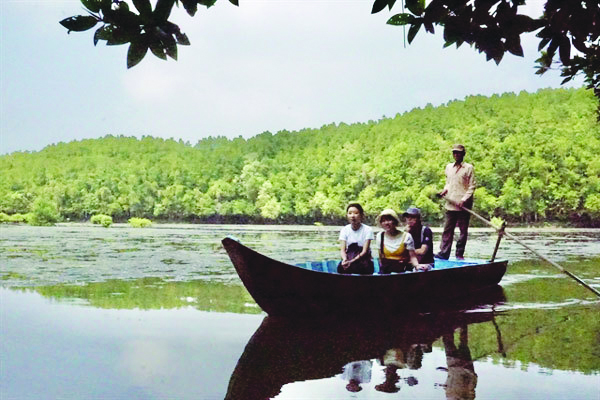 Features
Features

The outlying district of Cần Giờ in HCM City is becoming an ideal eco-destination for stressed-out urbanites to visit on two-day, one-night tours as it is considered one of the safest places in the city amid the COVID-19 pandemic

|
| Tourists on a bicycle ride in Thiềng Liềng Hamlet in the Thạnh An Island Commune of Cần Giờ District. Photo baotintuc.vn |
The outlying district of Cần Giờ in HCM City is becoming an ideal eco-destination for stressed-out urbanites to visit on two-day, one-night tours as it is considered one of the safest places in the city amid the COVID-19 pandemic
by Xuân Đăng
HCM City authorities have recently been developing tourism activities in Cần Giờ District to help revive the local economy after a long hiatus due to social distancing restrictions.
Cần Giờ, the only coastal district in the city, has advantages to develop a night economy, according to many tourism companies. Despite the potential, though, most commercial activities in the district stop at 7-8pm, with only 3-4 per cent of the total number of visitors staying overnight in the area, according to Trương Tiến Triển, deputy chairman of Cần Giờ.
The district has long been famous for fresh seafood, eco-tourism sites and the Cần Giờ Mangrove Forest, a biological reserve recognised by the UN cultural agency UNESCO. It also has many traditional craft villages.
Ecotourism is becoming increasingly popular here and Cần Giờ's combination of beauty, wilderness and adventure means it will likely become a travel magnet in the next few years.
Tourism businesses have asked the HCM City government to develop a support policy for businesses to invest long-term in Cần Giờ District tourism.
Võ Anh Tài, deputy general director of Saigon Tourism Corporation (Saigontourist Group), said that it started tours in Cần Giờ after the lockdown was lifted, but noted that more investment would be needed for transport infrastructure as well as commercial and service development.
One of the first efforts to revive the tourism sector this year was the Saigontourist Group's river tour on October 24 from Bạch Đằng wharf in downtown HCM City to tourist attractions in Cần Giờ District.
Fifty tourists left for Vàm Sát Ecological Park and Thiềng Liềng Island in Cần Giờ on a Greenlines high-speed ferry. They cruised on the Sài Gòn River and explored the Cần Giờ wetlands and sampled the area’s signature dishes.

|
| Tourists ride bicycles in Thiềng Liềng Hamlet, Cần Giờ District. Photo baotintuc.vn |
Jean Philippe Lovotti, who joined the tour, said he was excited to be able to travel again after the lockdown period in the city.
Earlier, in September, the district welcomed the first tour after months of social distancing. It was a closed model arranged for frontline medical staff to honour their hard work amid the pandemic.
The district is famous for its vast mangrove forests and wildlife sanctuaries, and was named the first Mangrove Biosphere Reserve in Việt Nam in 2000 by UNESCO.
Nguyễn Thị Ánh Hoa, director of the city's Department of Tourism, said the river tour aimed to diversify safe travel products and revive the tourism industry.
The department is working with travel firms and local authorities to run more river tours, including tours for Bạch Đằng-District 7-Cần Giờ, and Bạch Đằng-Củ Chi-Bình Dương.

|
| A view of Cần Giờ Mangrove Biosphere Reserve in HCM City’s Cần Giờ District. VNS Photo Thu Hằng |
Last month, the authorities of the district and the city discussed a new site for the Cần Giờ night market, which is expected to open in the first quarter of next year.
The district has selected two location options for the night market. The first option would include a night market at Hàng Dương Market, with a total area of 615sq.m. The second option would be an area for a night market food along the coast in Cần Thạnh Town.
The night market would operate from 4pm to 11pm on weekends and holidays, and open in the first quarter of 2022 before the Lunar New Year.
According to the Cần Giờ People’s Committee, the district received over 10.3 million visitors between 2015 and 2020, with the number growing at 31.4 per cent a year on average, but only 3-4 per cent of them stayed overnight because there were few attractions.
Cần Giờ has interesting landscapes, and historical and cultural sites that could attract more tourists. Besides its six famous tourism sites such as Monkey Island, Hàng Dương Seafood Market, the Vàm Sát Ecological Tourist Area, and Rừng Sắc, there are now 18 accommodation facilities with a capacity for 1,400 tourists, along with 10 high-quality restaurants and 49 local eateries.
According to the city's Department of Tourism, Cần Giờ is a strategic location for tourism since it is a hub connecting HCM City with neighbouring provinces like Bà Rịa-Vũng Tàu and Long An. The tourism industry in HCM City has identified the district as a place to welcome mid-income and upscale tourist segments in both the short and long term.
The director of the department suggested that the district first concentrate on the integration model between dining and shopping and other river cruise models. They should also try to attract more investment in transport infrastructure.
Many businesses in Cần Giờ have asked the city authorities to develop a stable support policy for investors, and promote production of specialties to attract more overnight stays and spending.
Eco-tourism focus
From the central HCM City, there are two ways to get to the eco-tourist site.
The first is biking or motorbiking to Bình Khánh Ferry which crosses the river to Cần Giờ Street. A short ride down the street is the Vàm Sát Ecological Tourist Area (Khu du lịch sinh thái Vàm Sát) in the Cần Giờ Mangrove Forest.
The second, and more interesting way, is to take a boat at the Bạch Đằng Wharf and glide down the Sài Gòn, Soài Rạp, Đinh Ba and Lò Rèn rivers.
Cần Giờ, which has a natural area of more than 75,000ha, is the only district bordering the sea in HCM City with 23km of coastline.
The district has eco-tourism advantages such as forest resources (especially mangroves); marine resources, rivers and canals; traditional craft villages such as the salt village of Thiềng Liềng Hamlet, the bird farming village in Tam Thôn Hiệp Commune, and the fishing village in Long Hòa Commune; and many worship places.

|
| Tourists take a boat trip around the mangrove forest. VNS Photo Thu Hằng |
Located 50km southeast of the city centre, the Cần Giờ wetlands can be visited easily by speedboat, car, motorbike or bus.
Known as the "green lung” of HCM City, the Mangrove Biosphere Reserve contributes to improving air quality in the city.
The reserve of more than 75,000ha was recognised in 2000 by UNESCO as the first Mangrove Biosphere Reserve in Việt Nam and is a member of the global biosphere reserve network.
Wildlife such as bats, birds, saltwater crocodiles and macaques are found at the Vàm Sát Ecological Park, a section of the Mangrove Biosphere Reserve.
The 600-hectare Vàm Sát natural bird sanctuary is home to 70,000 birds of 26 species. Visitors can observe thousands of birds flying around during the nesting season from April to October.
At Vàm Sát, tourists can also board rowboats to explore the bat swamps where fruit bats nest.
The Rừng Sác Guerrilla Base, Dần Xây Mangrove Park, Monkey Island and the city-level architectural site Ông Thuỷ Tướng Temple (Temple Worshipping the Whale) are also appealing tourist attractions in Cần Giờ.
To diversify tourism products and create more income for local people through tourism, the Thạnh An Commune People's Committee has set up a cooperative in Thiềng Liềng Hamlet that offers services for dining, accommodations and sightseeing for guests participating in tours.

|
| Cần Giờ District welcomes back tourists after months of social distancing. Photo nld.com.vn |
Last year, the People's Committee of Cần Thạnh Town established a cooperative group for ecotourism with 20 tourism business members that provide services such as garden tours, dining, fishing and national 'Đờn ca tài tử Nam Bộ' (Southern amateur music).
The district plans to survey the resources and potential of each commune and town to determine suitable tourism models for each locality. It will also focus on training local human resources in tourism skills such as communications, sales and customer care, and will set up connections to other tourist destinations and upgrade transport infrastructure. VNS




